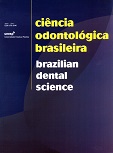Oral health educative-preventive program at school
DOI:
https://doi.org/10.14295/bds.2008.v11i3.497Abstract
This study has the aim of evaluation two different educational methods as: explanatory folders and lectures, at the implementation of an educative-preventive program about oral health developed at elementary public schools in Araraquara (SP) city. The sample was constituted by schoolchildren from fifth and sixth grades of four schools selected by convenience, divided in two groups: GA (n=303) that received only the folders and GB (n=245) that read the folders and also attended lectures. A questionnaire was applied before and fifteen days after program. The distribution of frequency was calculated and after that, to intergroup comparison chi-square test was used, and intragroup, the McNemar test (α=0,05). Most of schoolchildren understand that the consumption of sugary food has to be done after main meals and they are able to associate sugar consumption with tooth decay, beyond they do not know that sugar belongs to carbohydrates group. A healthy meal was considered dependent of type of food for 52% of GA and 44% of GB before the program, and 48% and 39% fifteen days after it. Initially, only 31% of GA and 30% of GB knew the ideal moment for tooth brushing. Methods of plaque prevention seemed familiar to schoolchildren. There was a difficulty to define the features of periodontal disease. At intergroup analyses, there was statistical difference to questions 3,5,6,8 and 11, comparing two moments; at intragroup analyses, GA showed significant knowledge change only to question 4 while for GB, same occurred to questions 3,4,5,6,8 and 11, accusing more effectiveness to educational method adopted by GB. The isolated use of the folder has not increased the level of oral health information while the association of folder with lectures increased their knowledge.
Downloads
Downloads
Published
How to Cite
Issue
Section
License
Brazilian Dental Science uses the Creative Commons (CC-BY 4.0) license, thus preserving the integrity of articles in an open access environment. The journal allows the author to retain publishing rights without restrictions.
=================




























